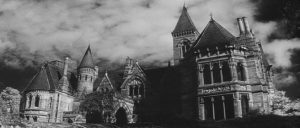One of the scariest films I have ever seen is the 1963 film The Haunting, directed by Robert Wise. It’s based on the novel The Haunting of Hill House by Shirley Jackson, and it’s the story of a paranormal investigator, Dr Markway, who persuades Mrs Sanderson, the owner of the empty Hill House, to allow him to rent it for a while to investigate its strange happenings and history of unusual phenomena. He invites several observers to accompany him, but only two actually arrive – the psychologically fragile Eleanor, who feels acute guilt at the recent loss of her mother (the death may have been due to Eleanor’s negligence), and who experienced poltergeist activity as a child; and Theodora, a self-regarding young lady who is apparently a psychic. The fourth member of the party is Luke, the nephew of the owner and at the house to keep at eye on things at her request.
The four settle into the house and begin to experience mysterious and disquieting events. But although the film is called The Haunting, there are no ‘ghosts’ to be seen. Instead, it works by the power of suggestion and our fear of the unknown. Continue reading


